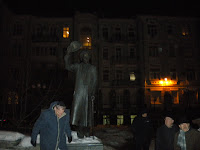Shabbat, we were on our own, I went to the Kotel friday night, bumping into several Skokie natives, davening was inspirational, and ate dinner by a rebbe of mine in the Old City. I studied with several students and spoke at an Oneg Shabbat for students at Yeshivat Netiv Aryeh.
Shabbat Day, I davened in Katamon area by Rav Binny Lau's shul and ate lunch with an old chavrusa in Sansimon. It was an apartment belonging to his in-laws, and happened to be the very first place that my wife and I were in the same room (about 9 years ago), though we didnt meet at the time!

Sunday morning, we visited Herodian, a place just outside of Jerusalem in the desert in which Herod constructed a palce and fortress. The Herodian sar on the flattened top of a hill that rises about 400 feet above the surrounding terrain. Though the roof and upper stories no longer exist, recent archaeology discoveries have unearthed the remains of what they believe to be Herod's tomb.
Inside the collosal structure are tunnels which were built for water storage and later used for hiding and military advantage in the time of the Bar Kochba revolt. One of the rooms, originally built as a banquet hall, is believed to have been used as a synagogue by the later inhabitants. Check out this video of the synagogue and mikvah at the end of this post!
One of the highlights for rabbis was to see our colleague Rabb
 i Zev Shandalov, who used to chair the JUF mission himself when he lived in Chicago.
i Zev Shandalov, who used to chair the JUF mission himself when he lived in Chicago.Sunday evening we had dinner with Rabbi Michael Melchior of the Meimad party and former Member of the Knesset.
We said sadly said goodbye to the Holy Land as we departed for Ben Gurion.
Monday monring, landed in Ohare...
looking forward to sharing these and more experiences with you.







